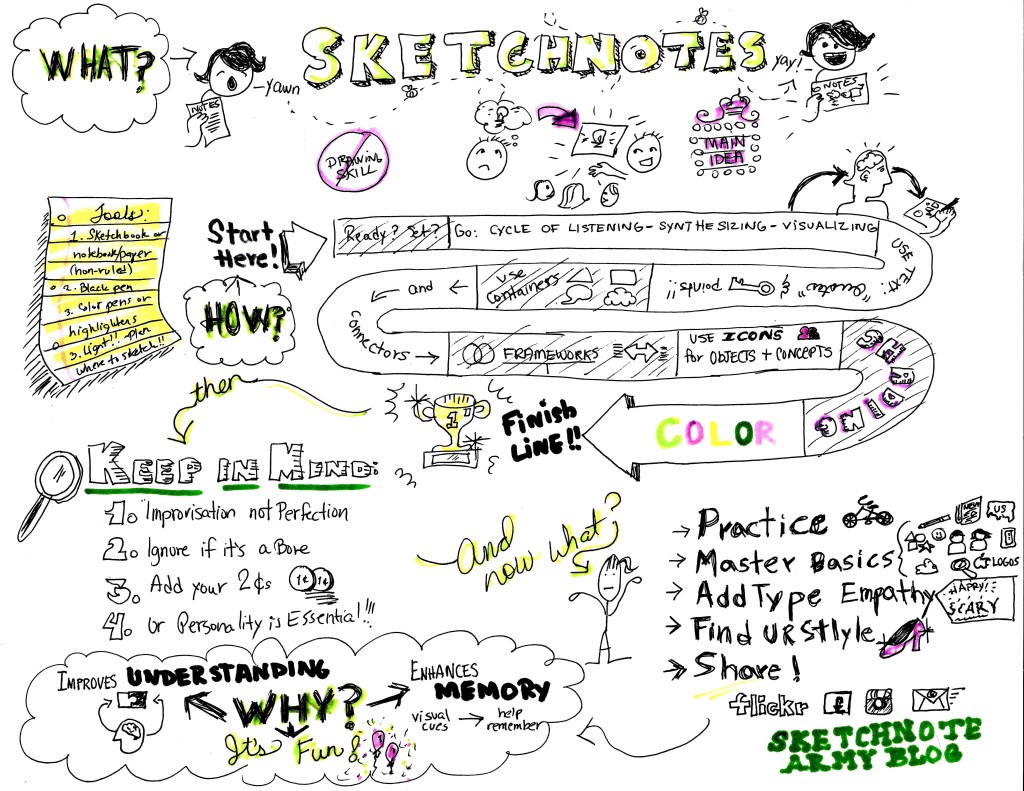Got Notes?
 Picture this:
Picture this:
You are in front of your screen, you have logged into your live lesson, and your instructor is about to start.
He or she reminds you to “take notes!” You find yourself unprepared, so you either open a Word document (which by the end of the lesson remains basically blank) or you hastily gather a pen and a paper napkin left in your room from last night’s pizza. At the end of the lesson, you barely have a few notes and the main idea of today’s lesson eludes you like the ghost of Christmas past…
Sigh…sound familiar?
You know that note-taking is an important skill, but sometimes as soon as you start summarizing on a yellow notepad or in a Word document you start to spell S-I-E-S-T-A instead! And to make matters worse, your notes start to grow cobwebs as soon as you file them. What would you say if I told you there is a better, smarter, and fun way to take notes?
Enter “Sketchnotes,” also known as visual note-taking. This method can take your notes from “yawn!” to “yay!” in no time if you are willing to learn and practice. Even though a Sketchnote is basically a merge between notes and doodles, it does not require drawing ability, so don’t be scared away if you think all you can draw is stick figures!
A Sketchnote helps you take an idea you hear and transfer it from your head to the paper.
This helps you easily organize the main ideas and details of a presentation to better remember what was said in a lecture yesterday, what was taught in a live lesson last week, or what you read in a course module a month ago. Think of Sketchnotes as personal infographics directed at the target audience: YOU!
Let’s get you started. First, make sure you have the necessary tools: sketchbook, notebook, or paper (non-ruled), black pen (fine point is best!), and some color pens or highlighters.
Once you’re ready, follow these steps:
- Start the cycle of listening-synthesizing-visualizing.
Continue listening as you sketch – don’t get lost in your note-taking and drawing!! I will show you some techniques to make sure you don’t miss anything important during a live lesson or lecture while your Sketchnoting improves in a future blog post.
- Use text for quotes and important concepts.
- Use containers such as boxes, speech bubbles, shapes, etc.
- Use connectors to connect related ideas.
- Use diagrams, especially if they are provided in the lecture or live lesson.
Sometimes taking a snapshot of the slide with your phone or a screenshot during a live lesson can help you quickly save it so you can add it to your Sketchnote later.
- Use icons for objects and concepts.
- Add shading.
You can do this with different pen techniques such as lines and dots or have a gray marker handy.
- When you feel ready, start to add color.
Highlight concepts and make your Sketchnotes more creative!
Remember, you are improvising and your drawings do not need to be perfect.
Make a mistake? Cross it out or draw over it. You do not need to include all the material. If it did not call your attention, leave it out and make sure you also add your own comments. If the teacher repeats it or points it out as important – add it to your note! You may also be wondering what the benefits of Sketchnoting are – and I will elaborate in a later post – but for now just know that research has shown this type of note-taking improves understanding and enhances memory. Just what you need for your next DBA!!
To get better, you need to practice. Start with a recorded live lesson or online lecture such as the TED Talks. Pick a topic of interest and sketch away! At the beginning, focus on mastering the basics such as shapes, icons, and logos, and experiment with different fonts until you find a style that suits you. Finally, share your work! You probably already have a Flickr, Facebook, or Instagram account or you can just email your best work to a friend or teacher. Check out the Sketchnote Army blog for inspiration.
And yes, here is my Sketchnote for this post:


Can’t wait to try sketch noting in my classes!
Katie, I would love to hear how sketchnoting has helped you, keep in touch!